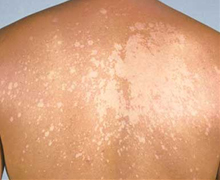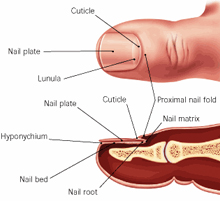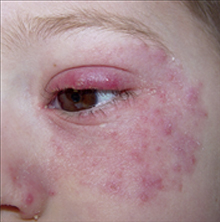
Mycosis (plural: mycoses) is a condition in which fungi pass the resistance barriers of the human or animal body and establish infections.
Classification
Mycoses are classified according to the tissue levels initially colonized:
(a) Superficial mycoses
Superficial mycoses - limited to the outermost layers of the skin and hair.
An example of a fungal infection is Tinea versicolor: Tinea versicolor is a fungus infection that commonly affects the skin of young people, especially the chest, back, and upper arms and legs. Tinea versicolor is caused by a fungus that lives in the skin of almost all adults. It doesn't usually affect the face. This fungus produces spots that are either lighter than the skin or a reddish-brown.

(b) Cutaneous mycoses
Cutaneous mycoses - extend deeper into the epidermis, as well as invasive hair and nail diseases. These diseases are restricted to the keratinized layers of the skin, hair, and nails. Unlike the superficial mycoses, host immune responses may be evoked, resulting in pathologic changes expressed in the deeper layers of the skin. The organisms that cause these diseases are called dermatophytes. The resulting diseases are often called ringworm (even though there is no worm involved) or tinea. Cutaneous mycoses are caused by Microsporum, Trichophyton, and Epidermophyton fungi, which together comprise 41 species.
(c) Subcutaneous mycoses
Subcutaneous mycoses - involve the dermis, subcutaneous tissues, muscle, and fascia. These infections are chronic and can be initiated by piercing trauma to the skin, which allows the fungi to enter. These infections are difficult to treat and may require surgical interventions such as debridement.

(d) Systemic mycoses due to primary pathogens
Systemic mycoses due to primary pathogens - originate primarily in the lungs and may spread to many organ systems. Organisms that cause systemic mycoses are inherently virulent. Generally, primary pathogens that cause systemic mycoses are dimorphic.
(e) Systemic mycoses due to opportunistic pathogens
Systemic mycoses due to opportunistic pathogens - infections of patients with immune deficiencies who would otherwise not be infected. Examples of immunocompromised conditions include AIDS, alteration of normal flora by antibiotics, immunosuppressive therapy, and metastatic cancer. Examples of opportunistic mycoses include Candidiasis, Cryptococcosis and Aspergillosis.
Prevention
Keeping the skin clean and dry, as well as maintaining good hygiene, will help larger topical mycoses. Because fungal infections are contagious, it is important to wash after touching other people or animals. Sports clothing should also be washed after use. Wearing flip-flops if using a community swimming pool or shower will also help prevent topical infections.
Treatment
Homeopathy provides a broad range of medicines even to the infections resistant to Allopathic anti fungal drugs.You can get rid of the fungal infection permanently by taking Homeopathic medicines.An expert Homeopathic physician could help you to select a constitutional medicine for your sufferings and to get rid of it permnantly.